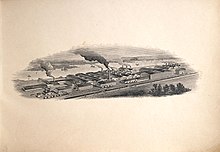


The American Encaustic Tiling Company was founded in New York, New York, in 1875, later establishing a factory in Zanesville, Ohio, in 1892. Their tiles were intended to compete with the English tiles that were selling in the United States for use in fireplaces and other architectural locations. The first glazed tiles were made in 1880 and embossed tiles were made in 1881. By 1890, they were the largest tile company in the world, and the small town of Zanesville nearly tripled in size over a thirty-year period as more people found work with the company. The firm closed in 1935 and was then reopened in 1937 as the Shawnee Pottery.

Their tiles form a mural at the Borden's Dairy Factory at 2840 Atlantic Avenue in East New York.
Designers and architects of the original New York subway stations partnered with Encaustic to develop color and decoration schemes fur the future stations. An exhibit was paved in the future Columbus Circle station in 1901. It was covered up before the station opened in 1904. Encaustic lost the overall contract to The Greuby Faience Company, Encaustic's product did make it into some stations, and some of the work survives.
Gallery
References
- Dunlap, David W. (2 November 2007). "A Decorative Piece of Subway History is Unearthed in a Busy Station". The New York Times. Retrieved 28 March 2018.
- "Encaustic Mosaic Tile Patterns Come Back to Life". www.architectmagazine.com. Retrieved 2021-11-08.
- Shaw, Tony. "The United States Tile Industry: A Historical Timeline". Aplus. Retrieved 28 March 2018.
- "American Encaustic Tiling Company". Kovels. Retrieved 28 March 2018.
- "Empire State Dairy in East New York Designated a NYC Landmark". Untapped Cities. 5 December 2017. Retrieved 28 March 2018.
- Suzanne Spellen (October 1, 2014). "Building of the Day: 2840 Atlantic Avenue". Brownstoner.
- Dunlap, David W. (2007-11-02). "A Decorative Piece of Subway History Is Unearthed in a Busy Station". The New York Times. ISSN 0362-4331. Retrieved 2024-01-05.
- Waldman, Benjamin (2011-09-19). "Urban Archaeology: Columbus Circle Subway Station". Untapped New York. Retrieved 2024-01-05.
- Ruvkun, Andrew (2013-04-14). "Tile Panels in Subway". New-York Historical Society Sunday Scholars. doi:10.1080/00119253.1935.10740995. ISSN 0011-9253.
This United States manufacturing company–related article is a stub. You can help Misplaced Pages by expanding it. |







